The first part of the balance sheet is the Assets section. When developing this section, you divide assets into two categories: current assets and long-term assets. Remember that you can find most of the information you need to prepare a balance sheet on your trial balance worksheet.
Current assets
Current assets are things your company owns that you can easily convert to cash and expect to use in the next 12 months to pay your bills and your employees. Current assets include the following:
Cash
Accounts Receivable (money due from customers)
Marketable securities (including stocks, bonds, and other types of securities)
Inventory
When you see cash as the first line item on a balance sheet, that account includes what you have on hand in the register and what you have in the bank, including checking accounts, savings accounts, money market accounts, and certificates of deposit. In most cases, you simply list all these accounts as one item, Cash, on the balance sheet.
As an example, the current assets for a fictional company are:
Cash $2,500
Petty Cash $500
Accounts Receivable $1,000
Inventory $1,200
You total the Cash and Petty Cash accounts, giving you $3,000, and list that amount on the balance sheet as a line item called Cash.
Long-term assets
Long-term assets are things your company owns that you expect to have for more than 12 months. Long-term assets include land, buildings, equipment, furniture, vehicles, and anything else that you expect to have for longer than a year.
The long-term assets for a fictional company are:
Equipment $5,050
Vehicles $25,000
Furniture $5,600
Most companies have more items in the long-term assets section of a balance sheet than the few long-term assets shown here for the fictional company. For example, a manufacturing company that has a lot of tools, dies, or molds created specifically for its manufacturing processes would have a line item called Tools, Dies, and Molds in the long-term assets section of the balance sheet.
Similarly, if your company owns one or more buildings, you should have a line item labeled Land and Buildings. And if you lease a building with an option to purchase it at some later date, that capitalized lease is considered a long-term asset and listed on the balance sheet as Capitalized Lease.
Land, buildings, capitalized leases, and leasehold improvements are tangible assets. These are items that you can actually touch or hold. Another type of long-term asset is the intangible asset. Intangible assets aren’t physical objects; common examples are patents, copyrights, and trademarks (all of which are granted by the government).
Patents give companies the right to dominate the markets for patented products. When a patent expires (14 to 20 years depending on the type of patent), competitors can enter the market for the product that was patented, and the competition lowers the price to consumers.
For example, pharmaceutical companies patent all their new drugs and therefore are protected as the sole providers of those drugs. When your doctor prescribes a brand-name drug, you’re getting a patented product. Generic drugs are products whose patents have run out, meaning that any pharmaceutical company can produce and sell its own version of the same product.
Copyrights protect original works, including books, magazines, articles, newspapers, television shows, movies, music, poetry, and plays, from being copied by anyone other than their creators.
Trademarks give companies ownership of distinguishing words, phrases, symbols, or designs. Trademarks can last forever as long as a company continues to use the trademark and file the proper paperwork periodically.
In order to show in financial statements that their values are being used up, all long-term assets are either depreciated or amortized. Tangible assets are depreciated. Intangible assets such as patents and copyrights are amortized (amortization is very similar to depreciation).
Each intangible asset has a lifespan based on the number of years the government grants the rights for it. After setting an initial value for the intangible asset, a company then divides that value by the number of years it has government protection, and the resulting amount is than written off each year as an Amortization Expense, which is shown on the income statement.
You can find the total amortization or depreciation expenses that have been written off during the life of the asset on the balance sheet in a line item called Accumulated Depreciation or Accumulated Amortization, whichever is appropriate for the type of asset.

